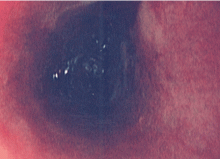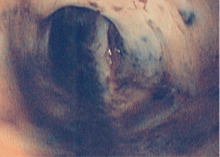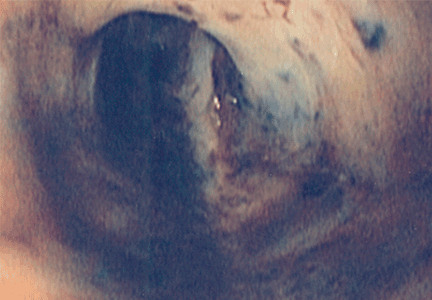User login
A 60-year-old man with a history of alcoholic cirrhosis and gastrointestinal bleeding was admitted after being found unconscious. He had coffee-ground emesis and melena.
ASSOCIATED CONDITIONS
TREATMENT AND COURSE
The treatment is mainly supportive, with intravenous fluids, proton pump inhibitors, and nothing taken orally.1 Complications include stricture, perforation, and death.1,3 The death rate is about 30% in these patients.3
- Khan AM, Hundal R, Ramaswamy V, Korsten M, Dhuper S. Acute esophageal necrosis and liver pathology, a rare combination. World J Gastroenterol 2004; 10:2457–2458.
- Le K, Ahmed A. Acute necrotizing esophagitis: case report and review of the literature. J La State Med Soc 2007; 159:330,333–338.
- Katsinelos P, Pilpilidis I, Dimiropoulos S, et al. Black esophagus induced by severe vomiting in a healthy young man. Surg Endosc 2003; 17:521.
A 60-year-old man with a history of alcoholic cirrhosis and gastrointestinal bleeding was admitted after being found unconscious. He had coffee-ground emesis and melena.
ASSOCIATED CONDITIONS
TREATMENT AND COURSE
The treatment is mainly supportive, with intravenous fluids, proton pump inhibitors, and nothing taken orally.1 Complications include stricture, perforation, and death.1,3 The death rate is about 30% in these patients.3
A 60-year-old man with a history of alcoholic cirrhosis and gastrointestinal bleeding was admitted after being found unconscious. He had coffee-ground emesis and melena.
ASSOCIATED CONDITIONS
TREATMENT AND COURSE
The treatment is mainly supportive, with intravenous fluids, proton pump inhibitors, and nothing taken orally.1 Complications include stricture, perforation, and death.1,3 The death rate is about 30% in these patients.3
- Khan AM, Hundal R, Ramaswamy V, Korsten M, Dhuper S. Acute esophageal necrosis and liver pathology, a rare combination. World J Gastroenterol 2004; 10:2457–2458.
- Le K, Ahmed A. Acute necrotizing esophagitis: case report and review of the literature. J La State Med Soc 2007; 159:330,333–338.
- Katsinelos P, Pilpilidis I, Dimiropoulos S, et al. Black esophagus induced by severe vomiting in a healthy young man. Surg Endosc 2003; 17:521.
- Khan AM, Hundal R, Ramaswamy V, Korsten M, Dhuper S. Acute esophageal necrosis and liver pathology, a rare combination. World J Gastroenterol 2004; 10:2457–2458.
- Le K, Ahmed A. Acute necrotizing esophagitis: case report and review of the literature. J La State Med Soc 2007; 159:330,333–338.
- Katsinelos P, Pilpilidis I, Dimiropoulos S, et al. Black esophagus induced by severe vomiting in a healthy young man. Surg Endosc 2003; 17:521.


